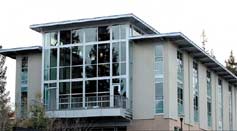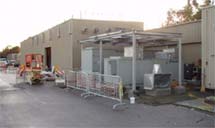

Monday – March 13, 2006
 |
 |
|
Monday – March 13, 2006 |

The Fred Kavli Building (Photo courtesy of Diana Rogers) Come Celebrate the Fred Kavli BuildingFor nearly two years, SLAC has watched the The Fred Kavli Building take shape little by little and piece by piece. And now it’s ready. This Friday afternoon marks your opportunity to explore SLAC’s newest building. On March 17, from 3:00 to 4:30 pm, all SLAC staff and users are invited to get a feel for this newest part of the lab. In addition to exploring the building, visitors are also invited to learn about the science of KIPAC. Researchers will be on hand to explain their work and light refreshments will be served. The building represents an important commitment to a new generation of science—bridging the worlds of experimental and theoretical particle astrophysics—in the hope of making new and exciting discoveries in these crucial fields. KIPAC Director Roger Blandford and Deputy Director Steven Kahn invite you to celebrate the dedication of SLAC's newest building. |
||||||||||||||||||||||||||
|
|
||||||||||||||||||||||||||
 Is there a crisis in science education in the US? Some people think so. The National Academies report Rising above the Gathering Storm has made a considerable impression in Washington. The report expressed "deep concern that the scientific and technological building blocks critical to our economic leadership are eroding at a time when many other nations are gathering strength." Partly in response to this report, President Bush announced his American Competitiveness Initiative (ACI) in his January State of the Union Address. The initiative's goal is to maintain U.S. leadership in science and technology so as to guarantee future economic strength and security for the nation. One resource is critical in achieving this goal—young people with an excellent education in science. Here SLAC can help. Science education is an intrinsic and crucial element of SLAC's mission. As a school of the University, we are naturally involved in the education of undergraduate and graduate students at Stanford. However, there is also an urgent need to make major improvements to the science education of K-12 students. The DOE national labs are expected to assume a significant and expanded role in achieving this. Read more... |
Sector 20 Project Nears Completion
The construction phase of the Sector 20 facility is almost complete. The 2,200 square-foot building is slated to house the LCLS drive laser. The drive laser will create the LCLS's initial laser beam. Once the project is complete, the beam will be focused on a cathode inside the radio frequency gun, which will release an electron bunch. This bunch will accelerate through the linac and slalom back and forth in the undulator, generating the world's first hard x-ray free electron laser pulses. SLAC staff and XL Construction have worked steadily on the Sector 20 facility since August of last year. Engineers involved in the project say it will be completed in early April. But the job does not end there. The building must also be completely cleaned and sealed to keep dust and dirt away from the sensitive equipment. Plus, cables and other equipment must be installed before the laser can be set up. "The Sector 20 facility will be ready just in time for the delivery of the drive laser," said Bill White, head of the LCLS laser group. |
Events (see all | submit)
Announcements
|
||||||||||||||||||||||||
| | ||||||||||||||||||||||||||
What's Cookin' at the Linear Cafe (see weekly menu)
|
||||||||||||||||||||||||||
|
|
||||||||||||||||||||||||||
 <%
Response.AddHeader "Last-modified", getArticleDate()
'Response.AddHeader "Last-modified","Mon, 01 Sep 1997 01:03:33 GMT"
'Monday, December 06, 2010
%>
<%
Response.AddHeader "Last-modified", getArticleDate()
'Response.AddHeader "Last-modified","Mon, 01 Sep 1997 01:03:33 GMT"
'Monday, December 06, 2010
%>View online at http://today.slac.stanford.edu/. |
||||||||||||||||||||||||||